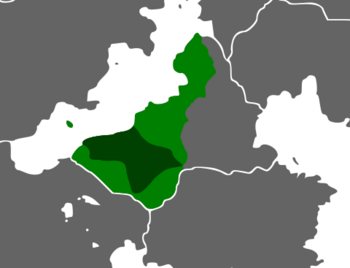Lushyodorstag
Kingdom of the Lushs Lushyodorstag | |||||||||
|---|---|---|---|---|---|---|---|---|---|
| 823 - 1913 | |||||||||
 Historical Lushyodor Kingdom in dark green, the Medenzag in green, and territorial expansions after the Ikonkivoyra in light green | |||||||||
| Religion | Docetic Christianism Emendatic Christianism | ||||||||
| Government | Monarchy | ||||||||
| Lushyodor Korran | |||||||||
• 820 - 840 | Garza III | ||||||||
• 1881–1913 (last) | Ansmar II | ||||||||
| History | |||||||||
• Baptism of Gerza III | 823 | ||||||||
| 1913 | |||||||||
| |||||||||
The Lushyodorstag or Kingdom of the Lushs was one of the two Finno-Ungaric languages Lush kingdoms that came from the partition of king Gerza I retinues. It was historically centered around the mountaineous region known as the Furodommark, even if with time it came to encompass all of modern southeastern Drevstran. While originally less wealthy than its eastern counterpart, and often considered to be a backwater, impoverished, region, The Lushyodorstag slowly emerged as one of the most important states in Eastern Belisaria following the Ikonkivoyra. It was notably one of the centers of the Eastern Renaissance (sometime nicknamed the "Alban Renaissance"), and one of the first state in the world to follow a policy of religious tolerance, with the first Edict of toleration published in 1259.
During the 13th and 14th centuries, the Lushyodorstag was known as the "Land of All the Heresies", being in its majority of Docetic confession, but also with important Emendatic and Orthodox Iconoclast communities. It was also considered to be a country of pirates and raiders, it's easily defensible borders, central position in Eastern Belisaria, poor natural ressources, and exclusion from both the Fabrian and Orthodox worlds that bordered it making it a privilegied origin for raiders, pirates, and mercenaries.
In 1690, Farza IV, king of the Lushyodors, inherited both the Principality of Yugstran and the Duchy of the Drev. But since these titles were part of [X] who refused to a see a foreign heretic in charge of these principalities, the Lushyodorstag began a long war to press their monarch's claim. Farza successfuly became the new Prince of Yugstran and Duke of the Drev after he defeated [X] armies in battle and converted to Orthodox Christianity, ending the war and uniting all three titles in a personal union known as the Triple Crown. The Lushyodorstag would continue as a constituent principality of what became known as Drevstran, until the beginning of the Drevstranese Civil War in 1913.
History
Ikonkivoyra
When its neighbor, the Kingdom of the Drev, began to implode because of internal turmoils and religious tensions, the Lushyodors took the opportunity to occupy bordering regions which had always been sources of contentions between the two states. They notably occupied the narrow pass known as the "Drev Gate" in 1023, but would lose it a decade later to the armies of the Sevromark. The two states would face regularly in the Sevro-Lush Wars, where the Lushyods would prove unable to push into the territories of the Sevromark, but where the newly created Iconoclast kingdom would also be unable, or unwilling, to follow through with its victory and contest the control of the Medenzag from their ennemies, as they were more concerned with the Duchy of Yugstran. The last of these conflicts ended in 1156 with the signature of a Treaty that fixed the border between the two states and forced the Lushyods to pay a small tribute to its neighbor. This peace would prove to be longlasting, and Lushyods mercenaries would serve in the Sevromark millitary during its last military campaigns and desesperate defense against the Neo-Bayarids.
Azdrheg Wars
Despite the Lushyod colonisation of the Medenzag, the control of this rich and fertile region would be permanently contested by the Kingdom of Azdraï. Following the peace treaty between the Lushyodorstag and the Sevromark and sensing the weakness of its southern neighbor, King Theodoric II invaded the Medenzag and the Mren Valley. Thourough the following century of conflicts, the Goths ended up taking over most of the north of the river valley, and even twice reached the Furodomark.
It's only with the end of the Ikonkivoyra that the Lushyods began to restructurate their military and their society, with the help of Iconoclasts generals and scholars who fled the Neo-Bayarids to find protection in the Lushyodorstag. Saul I, at the head of this reformed military, launched a devastating invasion that took the entirety of the Mren Valley from the Goths in 1293. A second campaign in 1294 culminated with the conquest of the Gothic capital, and three others between 1295 and 1298 finished all resistance in the Highlands. The collapse of the Azdraï state was complete in 1297, with the death of Euric in battle.

